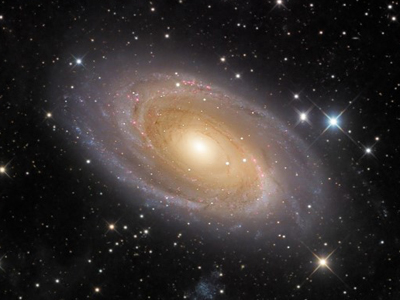
Ask the AI Tutor
Need help with Physics - Waves from Space (AQA)? Ask our AI Tutor!
AI Tutor - Lucy
Connecting with Tutor...
Please wait while we establish connection

The Doppler effect shows that most distant galaxies are moving away from us.
Physics - Waves from Space (AQA)
Waves from space bring us information about distant stars and galaxies. Discover how radio, infrared and other electromagnetic waves reach Earth and what telescopes can detect.
1 .
Which of the following waves can be changed by the Doppler effect?
Light waves
Sound waves
Microwaves
All of the above
Any wave whose source is moving is subject to the Doppler effect
2 .
When the source of a wave moves towards the observer, which of the following is not true?
The frequency of the waves is higher
If the wave is a light wave from a distant galaxy, the light is red-shifted
The wavelength of the waves is less
If the wave is a sound wave, the pitch sounds higher than it would if the source was stationary
Light from a galaxy that is approaching ours would be blue-shifted, not red-shifted
3 .
Galaxies emit (give out) many different types of wave. Which of the following would not be emitted by a galaxy?
Sound
Light
Infrared
X-rays
Sound waves are longitudinal waves and cannot travel through the vacuum of space
4 .
Scientists measuring radio waves from a distant galaxy find the wavelength of the waves they have detected is longer than it should be. What is this called?
Long-shift
Wave-shift
Red-shift
Radio-shift
It doesn't matter what type of electromagnetic radiation you are looking at, if the wavelength has been increased it is still called red-shift
5 .
Scientists discovered that all of the distant galaxies they looked at showed red-shift. What does that tell us about the direction that most galaxies are moving?
They are moving away from us
They are moving towards us
They are neither moving away nor towards us
Red-shift gives no information about how galaxies are moving
Scientists talk about the 'recession of the galaxies'. Recession is an alternative way of saying that the galaxies are moving away from our galaxy
6 .
What information does the red-shift of a galaxy give us?
Its distance and number of stars in the galaxy
Its speed and the number of stars it contains
Its weight and the speed it is moving away
Its distance and the speed of recession
Galaxies often occur in clusters. Our Galaxy is called the 'Milky Way' and is a part of what is called the 'Local Cluster'. Only galaxies in the Local Cluster are blue-shifted and are therefore moving towards us
7 .
What conclusion can be drawn from the fact that nearly all galaxies are moving away from us?
Galaxies repel each other like magnets
The Universe is shaped like a hill and the galaxies are rolling down the hill
Galaxies all have the same electrical charge
The Universe is expanding
American astronomer Edwin Hubble is credited with the discovery that the Universe is expanding. It is possible that a Belgian mathematician, Georges Lemaitre, came to the same conclusion some years before Hubble. Hubble came up with the law named after him. Hubble's Law states that the further away a galaxy is, the faster it is moving
8 .
Which theory about the formation of the Universe is supported by its expansion?
Steady State
Big Bang
Big Crunch
The Oscillating Universe Theory
The term Big Bang was coined by British astronomer Sir Fred Hoyle who actually preferred the Steady State theory
9 .
In 1964, American radio astronomers Arno Penzias and Robert Wilson discovered the cosmic microwave background radiation (CMBR). Why was this an important discovery?
It proved beyond doubt that the Big Bang theory was completely correct
It proved that the Universe will never stop expanding
It provided good evidence to support the Big Bang theory
It completely disproved the Steady State theory
In science, theories are rarely proved beyond any doubt. In time, the Big Bang Theory may even be dropped completely in favour of another that fits the evidence better
10 .
As the Universe gets older, what might happen to the cosmic microwave background radiation?
Its wavelength could increase
It may become stronger
It will suddenly disappear
It will turn into visible light
It is thought that its wavelength will increase as the Universe expands further and cools down even more. The CMBR is currently at a temperature of about 3 K - that's a pretty chilly minus 270oC
You can find more about this topic by visiting BBC Bitesize - Transverse and longitudinal waves - AQA
**Unlimited Quizzes Await You! 🚀**
Hey there, quiz champ! 🌟 You've already tackled today's free questions.
Ready for more?
Ready for more?
🔓 Unlock UNLIMITED Quizzes and challenge yourself every day. But that's
not all...
not all...
🔥 As a Subscriber you can join our thrilling "Daily Streak" against other
quizzers. Try to win a coveted spot on our Hall of Fame Page.
quizzers. Try to win a coveted spot on our Hall of Fame Page.
Don't miss out! Join us now and keep the fun rolling. 🎉
**Unlimited Quizzes Await You! 🚀**
Hey there, quiz champ! 🌟 You've already tackled today's free questions. Ready for more?
🔓 Unlock UNLIMITED Quizzes and challenge yourself every day. But that's not all...
🔥 As a Subscriber you can join our thrilling "Daily Streak" against other quizzers. Try to win a coveted spot on our Hall of Fame Page.
Don't miss out! Join us now and keep the fun rolling. 🎉






